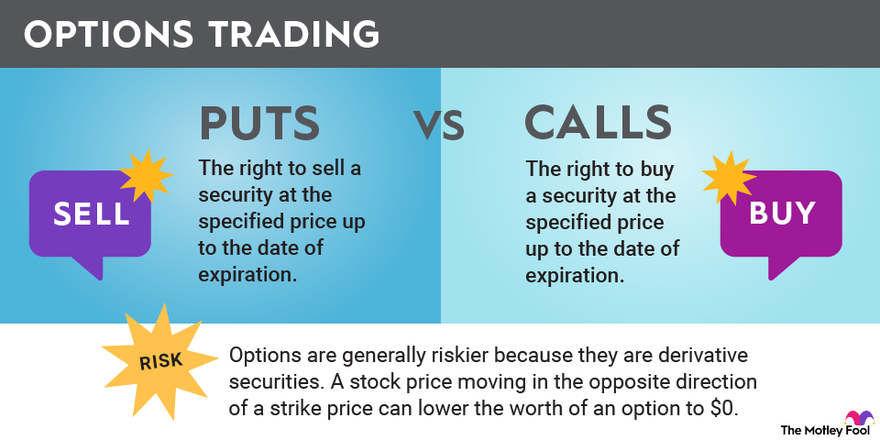Introduction:
In the realm of financial markets, the world of options trading offers a unique and compelling opportunity for savvy investors. Among the various options available, puts and calls stand out as two of the most popular and versatile instruments. By understanding the intricacies of trading options puts and calls, investors can strategically navigate the market landscape and make informed decisions that align with their financial goals.

Image: www.youtube.com
Unveiling Options Trading: Puts and Calls
Options, in essence, represent contracts that grant the buyer (the option holder) the right, but not the obligation, to either buy (in the case of calls) or sell (in the case of puts) an underlying asset (such as stocks, commodities, or currencies) at a predetermined price (the strike price) on or before a specified date (the expiration date).
-
Call Options: Call options convey the right to buy the underlying asset at the strike price on or before the expiration date. When investors anticipate an upward movement in the underlying asset’s price, they typically consider purchasing call options. If the price of the underlying asset rises above the strike price, the holder of the call option stands to profit from the difference between the two prices.
-
Put Options: Put options, on the other hand, confer the right to sell the underlying asset at the strike price on or before the expiration date. Investors opt for put options when they foresee a decline in the underlying asset’s price. If the price of the underlying asset falls below the strike price, the holder of the put option can capitalize on the price disparity.
Trading Strategies for Options Puts and Calls
-
Bullish Calls: When investors expect the underlying asset’s price to increase, they can strategically purchase call options with a strike price set below the current market price. This allows them to potentially reap significant profits if their bullish prediction proves accurate.
-
Bearish Calls: In anticipation of a price decline, investors can choose to sell (write) call options with a strike price above the current market price. If the underlying asset’s price indeed falls, the call seller could generate income from the premium paid by the buyer of the call option.
-
Protective Puts: Put options can serve as a valuable safety net for investors holding long positions in an underlying asset. By purchasing put options with a strike price below the current market price, investors can hedge against potential losses in case the underlying asset’s price plummets.
-
Bullish Spreads: Bullish spreads involve the simultaneous purchase of a call option at a lower strike price and the sale of a call option at a higher strike price with the same expiration date. This strategy is often employed when investors anticipate a moderate increase in the underlying asset’s price.
-
Bearish Spreads: Conversely, bearish spreads entail the simultaneous sale (writing) of a call option at a lower strike price and the purchase of a call option at a higher strike price with the same expiration date. This strategy is suitable when investors expect a moderate decline in the underlying asset’s price.
Expert Insights and Actionable Tips: Navigating the Options Market
-
Understand Risk and Volatility: Options trading carries inherent risks, particularly for novice investors. Thoroughly comprehend the dynamics of the options market and assess your risk tolerance before venturing into this realm. Volatility, the degree of price fluctuations in the underlying asset, can significantly impact the value of options.
-
Choose Expirations Wisely: Strategically select the expiration dates for your options based on your market outlook and investment time horizon. Short-term options (those with expirations within a few months) are more sensitive to price changes and carry higher premiums. In contrast, long-term options (those with expirations beyond a year) are less sensitive to price movements and have lower premiums.
-
Monitor Market Conditions: Keep a keen eye on economic indicators, company-specific news, and overall market sentiment. Staying informed about these factors can provide valuable insights into potential price trends and help you make informed decisions when trading options puts and calls.
-
Consider Option Strategies to Align with Market Expectations: As discussed earlier, various options trading strategies can be tailored to specific market expectations. By carefully choosing the appropriate strategy, you can optimize your chances of profitability while managing risk effectively.

Image: www.pinterest.com
Trading Options Puts And Calls

Image: www.fool.com
Conclusion
Trading options puts and calls opens up a realm of opportunities for savvy investors. By gaining a comprehensive understanding of these instruments, investors can make informed decisions, develop tailored strategies, and navigate the complexities of the financial markets with increased confidence. Remember, while the allure of potential profits can be enticing, it’s imperative to exercise due diligence, manage risk judiciously, and seek guidance from experienced professionals when necessary. As you embark on your options trading journey, may this guide serve as a beacon of knowledge, empowering you to make informed and strategic decisions.






